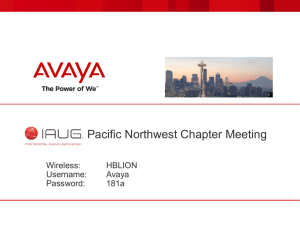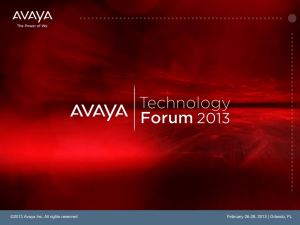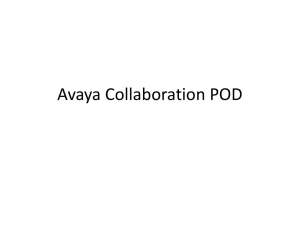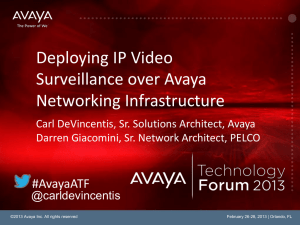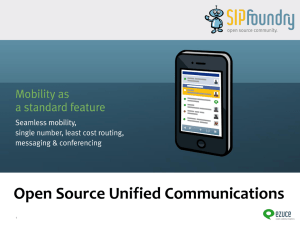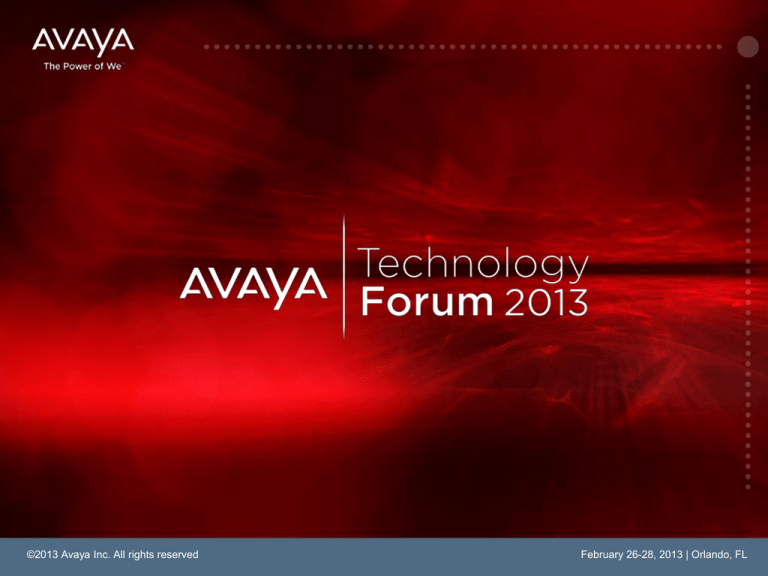
©2013 Avaya Inc. All rights reserved
February 26-28, 2013 | Orlando, FL
Deploying Services over
Avaya Fabric Connect
Jeff Cox
Senior Solutions Architect
Avaya
#AvayaATF
@jeffcox65
©2013 Avaya Inc. All rights reserved
February 26-28, 2013 | Orlando, FL
Agenda
•
•
•
•
•
SPBM Overview
CFM (Connectivity Fault Management) 802.1ag
SPBM – SMLT
SPBM Services
SPBM Configuration
©2013 Avaya Inc. All rights reserved
3
February 26-28, 2013 | Orlando, FL
SPB Overview
• Shortest Path Bridging is defined in the IEEE 802.1aq standard
• 802.1aq Summary
•
•
•
•
•
•
•
•
•
•
•
Build much larger networks than today’s STP networks
Multiple equal cost paths
Fast convergence
Support for large mesh networks
Scalability – addresses Mac address explosion
Loop prevention & suppression
Use all links. Does not block and waste link resources
Use shortest path for unicast and multicast traffic
Service virtualization (L2, L3 VPNs)
Simple encapsulation
CFM – Connectivity Fault Management – Layer 2 ping, traceroute,
tracetree
©2013 Avaya Inc. All rights reserved
4
February 26-28, 2013 | Orlando, FL
SPB Overview
Continued
• 802.1aq supports two modes, SPB VID (SPBV) and SPB MAC
(SPBM) where the ERS 8600/8800 supports SPBM
• SPBV uses Q-in-Q IEEE 802.1ad encapsulation
• SPBM uses MAC-in-MAC IEEE 802.1ah
• Control protocol for 802.1aq is IS-IS* with a small number of TLVs
• IS-IS is only used on NNI links between SPB switches
• IS-IS is used to discover and advertise the network topology and
compute shortest path trees from all bridges in the SPB Region
• In SPBM, service instances are delineated by Logical Group
Identifiers (I-SID)
* Intermediate System to Intermediate System
©2013 Avaya Inc. All rights reserved
5
February 26-28, 2013 | Orlando, FL
Shortest Path Bridging MAC (SPBM)
Ethernet Encapsulation (MAC-in-MAC)
C-SA
C-DA
C-TAG
TPID
S-TAG
I-TAG
I-SID
B-TAG
B-DA
B-SA
= Customer Source MAC
= Customer Destination MAC
= Customer TAG
= Tag Protocol IDentifier
= Service TAG
= Service Instance TAG
= Service ID
= Backbone TAG
= Backbone DA
= Backbone SA
©2013 Avaya Inc. All rights reserved
6
February 26-28, 2013 | Orlando, FL
SPBM Terminology
•
•
•
•
•
•
•
•
•
•
•
•
BEB: Backbone Edge Bridge
BCB: Backbone Core Bridge
C-VLAN: Customer VLAN
B-VLAN: Backbone VLAN
B-MAC: Backbone MAC
C-MAC: Customer MAC
I-SID: Backbone Service
Instance, IEEE 802.1ah
SPB: Shortest Path Bridging
SPBM: Shortest Path Bridging
MAC
CFM: Connectivity Fault
Management
IS-IS: Intermediate System to
Intermediate System
TLV: Type Length Value
©2013 Avaya Inc. All rights reserved
7
February 26-28, 2013 | Orlando, FL
SPBM
Reference Details
•
SPBM needs to be enabled
on all core switches
•
•
•
•
IS-IS needs to be enabled
on all core switches
•
•
•
IS-IS area
System ID (recommended)
IS-IS Interface
•
•
•
Nick-name (x.xx.xx)
B-VLANs
IP (only for L3)
Only pt-to-pt
Enabled on port or MLT
I-SIDs are on C-VLANs
and/or VRFs to identify L2 or
L3 services
©2013 Avaya Inc. All rights reserved
8
February 26-28, 2013 | Orlando, FL
SPBM – L2VSN
What does it solve?
8600G
Inception:
8600A
3/11
3/5
8600C
3/1
MLT1
3/12
4/30
3/21
4/20
4/1
Tester
IST
4/30
4/12
8600D
IS-IS
3/21
SMLT
VLAN must be provisioned on
all switches, e.g. for VLAN 10,
configuration of VLAN 10 is
required on all switches
8600A
3/2
3/12
(SPBM)
3/3
3/1
3/22
4/30
3/29
3/30
3/29
3/30
MLT1
IST
Tester
4/29
4/11
4/29
©2013 Avaya Inc. All rights reserved
IST
8600B
VLAN 10
I-SID MLT
10 1
4/20
C-VLAN & I-SID mapping configured only on
edge. Customer MAC learning and flooding
only done on edge
3/30
3/2
3/11
3/5
4/1
VLAN 10
3/29
3/3
8600G
Target:
4/30
3/30
3/1
MLT30
8600C
3/29
Tester
4/11
4/29
Backbone VLANs in core running IS-IS
(SPBM)– simple one time configuration
MLT1
3/3
3/22
4/29
Core has to do MAC learning
and flooding
No end-point provisioning
Tester
3/2
3/3
3/1
4/12
VLAN 10
3/2
Core does not
learn Customer VLAN/MAC
8600D
9
SMLT
8600B
C-VLAN & I-SID mapping configured only on
edge. Customer MAC learning and flooding
only done on edge
February 26-28, 2013 | Orlando, FL
SPBM – GRT Shortcuts
What does it solve?
8600G
Tester
VLAN 1001
3/2
3/12
3/3
3/22
4/20
4/30
RSMLT
3/21
IST
4/29
4/29
RSMLT + OSPF in Core
3/5
4/30
10.0.1.0/24
4/1
VLAN 1001
4/29
4/29
IP Shortcuts over IS-IS
©2013 Avaya Inc. All rights reserved
4/12
3/2
3/29
3/29
3/30
IST10.0.2.0/24
VLAN 1002
3/30
3/1
8600D
8600B
IP Subnet C – IGP Protocol
8600G
8600A
Target:
Tester
3/3
MLT1
SMLT
Tester
MLT30
IP Subnet B – IGP Protocol
8600C
IP Subnet A – No IGP required
4/11
3/1
RSMLT
3/11
Two Core OSPF
Vlans:
Vlan 911 10.0.11.0/24
Vlan 912 10.0.12.0/24
MLT1
4/30
10.0.1.0/24
4/1
8600A
3/5
RSMLT
IP Subnet A – Passive or
active interface IGP8600C
Two Core OSPF
Vlans:
Vlan 921 10.0.21.0/24
Vlan 922 10.0.22.0/24
Inception:
3/11
3/2
3/12
3/3
IP Subnet D – IGP Protocol
3/1
3/21
IS-IS
MLT 1
3/22
3/29
4/20
4/30
3/29
4/11
3/3
4/12
3/2
3/30
IST10.0.2.0/24
VLAN 1002
3/30
3/1
Backbone VLANs in core running IS8600D
8600B
IS simple
one time configuration
10
MLT1
SMLT
Tester
IP Subnet B– No IGP
required
February 26-28, 2013 | Orlando, FL
SPBM – L3VSN
What does it solve?
8600A
8600C
4/29
Tester
VRF
Configuration,
IGP
VLAN 1001
configuration, iBGP peering,
MPBGP, Route Targets,
Router Distinguishers
3/21
4/20
4/30
4/11
3/3
4/12
3/2
8600C
3/11
3/2
3/12
3/3
IST
3/29
3/30
3/1
3/1
3/21
3/22
4/20
4/30
I-SIDMLT
1011
10.0.101.0/24
4/1
4/29
©2013 Avaya Inc. All rights reserved
3/30
3/29
8600D
8600B
IP Subnet C – IGP Protocol
8600A
IS-IS (SPBM)
4/30
VRF Configuration &
I-SID mapping
VRF Configuration, IGP
configuration, iBGP peering,
3/1
MPBGP, Route Targets,
MLT1 Router Distinguishers
MLT30
8600G
Tester
3/3
IST
3/5
VLAN 101
3/12
3/22
4/29
IP Subnet B – IGP Protocol
Target:
3/2
RSMLT
4/1
RSMLT
MLT1
4/30
3/11
RSMLT
3/5
Two Core OSPF
Vlans:
Vlan 911 10.0.11.0/24
Vlan 912 10.0.12.0/24
Inception:
Two Core OSPF
Vlans:
Vlan 921 10.0.21.0/24
Vlan 922 10.0.22.0/24
8600G
4/29
4/11
3/3
4/12
3/2
3/29
3/30
3/29
3/30
Tester
10.0.2.0/24
VLAN 1002
MLT1
IST
3/1
Backbone VLANs in core running IS-IS
8600Done time configuration
8600B
(SPBM)– simple
11
SMLT
SMLT
Tester
VLAN 102 VRF Configuration &
I-SID mapping
February 26-28, 2013 | Orlando, FL
SPBM
• SPBM (Shortest Path Bridging – MAC, previously
known as SPBB) provides additional values which
capitalize on IEEE 802.1ah (PBB) capabilities.
• SPBM reuses the IEEE 802.1ah (PBB) data plane
which does not require that the Backbone Core Bridges
(BCB) learn encapsulated client addresses (C-MAC).
• Individual MAC frames (unicast traffic) from an Ethernet
attached device that are received at the SPBM edge are
encapsulated in a (MAC-in-MAC) IEEE 802.1ah header and
then traverse the network unchanged until they are stripped of
the encapsulation as they egress back to the non participating
attached network at the far side of the participating network
©2013 Avaya Inc. All rights reserved
12
February 26-28, 2013 | Orlando, FL
SPB
Shortest Path Bridging
• The SPB service is made possible by adding a
new header with an I-SID, a BVLAN with
source and destination B-MAC addresses
• The B-VLAN is a 802.1Q VLAN used in the
core used to transport the PBB EVPNs
• the p-bits contained within the 802.1Q VLAN header
provide QoS capabilities
©2013 Avaya Inc. All rights reserved
13
February 26-28, 2013 | Orlando, FL
Shortest Path Bridging
•
The backbone simply provides forwarding between backbone switches
where the unicast-fib is populated by B-MAC
•
•
Each bridge has one unique MAC address known as the B-MAC and
advertised by IS-IS as the SYS-ID
On the ERS 8600/8800, this is the system-id which can be configured or left
as-is
• Good idea to change the system-id to easily identify switches in the IS-IS forwarding
table
ERS-2> show isis system-id
================================================================================
ISIS System-Id
================================================================================
SYSTEM-ID
-------------------------------------------------------------------------------00be.b000.0002
ERS-1> show isis spbm unicast-fib vlan 40
================================================================================
SPBM UNICAST FIB ENTRY INFO
================================================================================
DESTINATION
BVLAN SYSID
HOST-NAME
OUTGOING
COST
ADDRESS
INTERFACE
-------------------------------------------------------------------------------00:be:b0:00:00:02 40
00be.b000.0002
ERS-2
2/2
10
00:be:b0:00:00:03 40
00be.b000.0003
ERS-3
2/2
20
00:be:b1:00:00:03 40
00be.b000.0003
ERS-3
2/2
20
00:be:b0:00:00:04 40
00be.b000.0004
ERS-4
2/2
20
©2013 Avaya Inc. All rights reserved
14
February 26-28, 2013 | Orlando, FL
SPBM
I-SID L2 VSN
• The I-SID is the ‘Instance Service Identifier’ made up of a 24-bit
field providing over 16 million possible VSN-id’s. The I-SID is used
to identify the VSN service.
• Each I-SID is assigned a unique identifier (valid range 1 to 16777215)
• For L2 VSN, I-SID assigned at VLAN level
ERS-1# show config module vlan
#
# VLAN CONFIGURATION - PHASE I
#
vlan 1000 create byport 1 name "VSN-Blue"
vlan 1000 i-sid 1000
ERS-1# show isis spbm i-sid all
================================================================================
SPBM ISID INFO
================================================================================
ISID
SOURCE NAME
VLAN
SYSID
TYPE
-------------------------------------------------------------------------------1000
0.00.01
40
00be.b000.0001
config
1000
0.00.02
40
00be.b000.0002
discover
1000
0.00.03
40
00be.b000.0003
discover
1000
0.00.04
40
00be.b000.0004
discover
©2013 Avaya Inc. All rights reserved
15
February 26-28, 2013 | Orlando, FL
SPBM
I-SID L3 VSN
• For L3 VSN, I-SID assigned at VRF level
ERS-1# show config module ip
#
# VRF CONFIGURATION
#
ip vrf green create id 1
#
# IPVPN CONFIGURATION
#
ip vrf green ipvpn create
ip vrf green ipvpn i-sid 1002
ip vrf green ipvpn enable
#
# CIRCUITLESS IP INTERFACE CONFIGURATION - VRF
#
#
# IP REDISTRIBUTION CONFIGURATION - VRF
#
ip vrf green circuitless-ip-int
255.255.255.255
ip vrf green isis redistribute direct create
ip vrf green isis redistribute direct metric 1
ip vrf green isis redistribute direct enable
2 create 10.1.1.1/
ERS-1# show isis spbm ip-unicast-fib all
*******************************************************************************
Command Execution Time: WED DEC 01 09:39:04 2010 EST
*******************************************************************************
================================================================================
SPBM IP-UNICAST FIB ENTRY INFO
================================================================================
OUTGOING SPBM
VRF
ISID
Destination
NH BEB
VLAN INTERFACE COST
-------------------------------------------------------------------------------green
1002
10.5.1.3/32
ERS-3
40
2/2
20
green
1002
10.5.1.3/32
ERS-3
41
2/2
20
green
1002
10.5.102.0/24
ERS-3
40
2/2
20
green
1002
10.5.102.0/24
ERS-3
41
2/2
20
©2013 Avaya Inc. All rights reserved
16
PREFIX
COST
1
1
1
1
February 26-28, 2013 | Orlando, FL
SPBM
Unicast
• Unicast Ethernet frames in SPBM are encapsulated
with a destination B-MAC and a source B-MAC and a
backbone VLAN ID
• The backbone source address is a B-MAC associated with the
ingress 802.1aq bridge
• The backbone destination address is a B-MAC associated with
the egress 802.1aq bridge
• B-VID – 802.1aq specification allows for tagged or untagged
frames
• ERS 8600/8800 uses VLAN tagging
• The FDB entries map destination B-MAC, B-VID to an outgoing
interface based on IS-IS database and computations
©2013 Avaya Inc. All rights reserved
17
February 26-28, 2013 | Orlando, FL
SPBM
IS-IS LSDB Details 1 of 2
ERS-1# show isis lsdb sysid 00be.b000.0003 detail
===================================================
ISIS LSDB (DETAIL)
===================================================
--------------------------------------------------Level-1 LspID: 00be.b000.0003.00-00
SeqNum:
0x000004d9
Lifetime:
537
Chksum: 0xd4df PDU Length: 237
Host_name: ERS-3
Attributes:
IS-Type 1
TLV:1
Area Addresses: 1
10.0001
TLV:3
SPBM Sub TLV:
Instance: 0
Attr: 0
Metric: 10
TLV:129 Protocol Supported: SPBM
TLV:180 SPBM INSTANCE:
Instance: 0
Attr: 0
OUI: 00-00-03
End System Neighbors:
Metric: 0
00beb0000003 (ERS-3)
TLV:22
Extended IS reachability:
Adjacencies: 2
TE Neighbors: 2
00be.b000.0002.00 (ERS-2)
Metric:10
SPBM Sub TLV:
Instance: 0
Attr: 0
Metric: 10
00be.b000.0004.00 (ERS-4)
Metric:10
©2013 Avaya Inc. All rights reserved
18
February 26-28, 2013 | Orlando, FL
SPBM
IS-IS LSDB Details 2 of 2
TLV:184 SPBM IPVPN Reachability:
TLV:183 ISID:
Instance: 0
Metric: 0
B-MAC: 00-be-b0-00-00-03
BVID:40
Number of ISID's:2
1000(Both),1001(Both)
Vrf ISID:1002
Metric:1
B-VID
40
IP Address: 10.5.1.3
Vrf ISID:1002
Metric:1
Instance: 0
Metric: 0
B-MAC: 00-be-b0-00-00-03
BVID:41
Number of ISID's:2
1000(Both),1001(Both)
Instance: 0
Metric: 0
B-MAC: 00-be-b1-00-00-03
BVID:40
Number of ISID's:1
16777215(None)
©2013 Avaya Inc. All rights reserved
Prefix
Length:32
Prefix
IP Networks
Received
Via
I-SID 1002
Length:24
IP Address: 10.5.102.0
B-VID
41
Virtual
B-MAC
19
February 26-28, 2013 | Orlando, FL
SPBM
IS-IS Type Length Value (TLV) Details
•
Some important TLV details can be viewed by issuing the following
commands:
•
Area address – type 1
• show isis lsdb tlv 1 detail
•
End System Neighbors – type 3
• show isis lsdb tlv 3 detail
•
Extended IS Reachability Information – type 22
• show isis lsdb tlv 22 detail
•
Protocols Supported – type 129
• show isis lsdb tlv 129 detail
•
Extended IP Reachability – type 135 (SPB Native IP Shortcuts)
• show isis lsdb tlv 135 detail
•
Extended Reachability TLV – type 180
• show isis lsdb tlv 180 detail
•
SPBM IP Reachability TLV – type 184
• show isis lsdb tlv 184 detail
©2013 Avaya Inc. All rights reserved
20
February 26-28, 2013 | Orlando, FL
SPBM
Unknown Traffic
• SPBM uses source specific multicast trees
• SPBM (S,G) forms the destination B-MAC by
concatenating the 20 bit SPB unique nickname
and the 24-bit I-SID
• Broadcast, multicast and unknown unicast
frames arriving on a UNI port are:
• Encapsulated using this destination B-MAC address
for the I-SID defined
• The destination B-MAC uniquely identifies the
encapsulating node or root of the multicast distribution tree
©2013 Avaya Inc. All rights reserved
21
February 26-28, 2013 | Orlando, FL
SPBM
Unknown Traffic
• Example : ERS-1 Nickname = 0.00.01 , I-SID = 1000 (0x3e8)
Multicast Address = 03:00:01:00:03:e8
NICK-NAME & “3”
I-SID in Hexadecimal
ERS-1# show isis spbm multicast-fib i-sid 1000
================================================================================
SPBM MULTICAST FIB ENTRY INFO
================================================================================
MCAST DA
ISID
BVLAN SYSID
HOST-NAME
OUTGOING-INTERFACES
-------------------------------------------------------------------------------03:00:01:00:03:e8 1000
40
00be.b000.0001
ERS-1
2/2
03:00:01:00:03:e8 1000
41
00be.b000.0001
ERS-1
2/2
ERS-1# show isis spbm nick-name
================================================================================
ISIS SPBM NICK-NAME
================================================================================
LSP ID
LIFETIME NICK-NAME HOST-NAME
-------------------------------------------------------------------------------00be.b000.0001.00-00
334
0.00.01 ERS-1
00be.b000.0002.00-00
576
0.00.02 ERS-2
00be.b000.0003.00-00
828
0.00.03 ERS-3
00be.b000.0004.00-00
379
0.00.04 ERS-4
©2013 Avaya Inc. All rights reserved
22
February 26-28, 2013 | Orlando, FL
SPBM
Unknown Traffic – Constrained Multicast
•
•
Per Node multicast tree for each I-SID
Intermediate nodes only install multicast MAC address when they are in the path
86-20
2/11
2/12
86-10
86-30
2/11
2/10
2/1
2/12
2/11
2/12
86-10
2/11
2/10
All links active – No traffic going through 86-20
2/10
86-20
2/1
86-20:5# show isis spbm multicast-fib
================================================================
SPBM MULTICAST FIB ENTRY INFO
================================================================
MCAST DA
ISID
BVLAN SYSID
HOST-NAME
OUTGOING-F
-----------------------------------------------------------------------------------
2/12
2/10
2/1
86-20:5# # show isis spbm multicast-fib
================================================================
SPBM MULTICAST FIB ENTRY INFO
================================================================
MCAST DA
ISID
BVLAN SYSID
HOST-NAME
OUTGOING-IF
----------------------------------------------------------------------------------86-30
----------------------------03:00:10:00:00:64 100
10
0080.2d35.93df
86-10
2/12
03:00:10:00:00:c8 101
10
0080.2d35.93df
86-10
2/12
2/1 03:00:30:00:00:64 100
10
00e0.7b84.57df
86-30
2/11
03:00:30:00:00:c8 101
10
00e0.7b84.57df
86-30
2/11
Link failure between 86-10 / 86-30 – All traffic going through 86-20
©2013 Avaya Inc. All rights reserved
23
February 26-28, 2013 | Orlando, FL
Intermediate System to
Intermediate System (IS-IS)
• IS-IS is an interior gateway protocol (IGP) that was
developed for the International Organization for
Standardization (ISO DP 10589)
• Defined in ISO/IEC 10589:2002 as international standard within
Open Systems Interconnection (OSI)
• IETF republished in RFC 1142
• IS-IS is a link-state routing protocol
• Uses the Dijkstra algorithm for computing the best path through
network in common with OSPF
• SPBM uses IS-IS at layer 2, it does not need IP
addressing configured
©2013 Avaya Inc. All rights reserved
24
February 26-28, 2013 | Orlando, FL
Intermediate System to
Intermediate System (IS-IS)
• IS-IS differs from OSPF in the way areas are defined
and routed between
• Unlike OSPF, IS-IS is designed to work in one flat area
• IS-IS routers are designated as being Level 1 (intra-area),
Level 2 (inter-area), or Level 1-2 (both)
• Note: We only support Level 1 at this time
• Forwarding information is exchanged between Level 1 routers
• Level 2 routers only exchange information with other Level 2 or
Level 1-2 routers
• Does not required area 0 like OSPF
• A IS-IS router is only ever part of a single area
• IS-IS is protocol agnostic whereas OSPF was designed for
IPv4
©2013 Avaya Inc. All rights reserved
25
February 26-28, 2013 | Orlando, FL
Intermediate System to
Intermediate System (IS-IS)
Example: ERS-1 connected to ERS-2 via port 2/2
ERS-1# show config module isis
#
# ISIS CONFIGURATION
#
isis
isis
isis
isis
is-type l1
system-id 00be.b000.0001
manual-area add 10.0001
enable
ERS-1# show isis interface
================================================================================
ISIS Interfaces
================================================================================
IFIDX
TYPE
LEVEL
OP-STATE ADM-STATE ADJ
UP-ADJ SPBM-L1-METRIC
-------------------------------------------------------------------------------Port2/2
pt-pt
Level 1
UP
UP
1
1
10
ERS-1# show isis adjacencies
================================================================================
ISIS Adjacencies
================================================================================
INTERFACE L STATE
UPTIME PRI HOLDTIME SYSID
HOST-NAME
-------------------------------------------------------------------------------Port2/2
1 UP
01:49:31 127
18 00be.b000.0002
ERS-2
©2013 Avaya Inc. All rights reserved
26
ERS-1# show isis info
===========================================
ISIS General Info
===========================================
AdminState : enabled
RouterType : Level 1
System ID : 00be.b000.0001
Max LSP Gen Interval : 900
Min LSP Gen Interval : 30
Metric : wide
Overload-on-startup : 20
Overload : false
Csnp Interval : 10
PSNP Interval : 2
Rxmt LSP Interval : 5
spf-delay : 100
Router Name : ERS-1
ip source-address :
Num of Interfaces : 1
Num of Area Addresses : 1
February 26-28, 2013 | Orlando, FL
CFM – 802.1ag
©2013 Avaya Inc. All rights reserved
27
February 26-28, 2013 | Orlando, FL
IEEE 802.1ag
Connectivity Fault Management
• Connectivity Fault Management (CFM) offers loopbacks and link
trace for troubleshooting, and continuity checks for fast fault
detection.
• CFM allows operators, service providers and customers to verify
the connectivity that they provide or utilize and the connectivity that
is provided to them. This is accomplished through:
• Periodic messaging between endpoints within a domain for the
purpose of fault identification. (CCM)
• Loopback (aka L2 ping) messaging to an intermediate or endpoint
within a domain for the purpose of fault verification. (LBM)
• Linktrace (aka L2 trace) messaging to a maintenance endpoint with
intermediate points responding to indicate the path of the traffic within
a domain for the purpose of fault isolation. (LTM)
©2013 Avaya Inc. All rights reserved
28
February 26-28, 2013 | Orlando, FL
IEEE 802.1ag
Connectivity Fault Management
• Maintenance Domain – MD
• MD are management space on a network, typically owned and
operated by a single entity MD are configured with Names and
Levels, where the eight levels range from 0 to 7.
• Hierarchal relationship exists between domains based on
levels.
CUSTOMER
ETHERNET
ACCESS
ETHERNET
ACCESS
CORE
CUSTOMER
Customer level (7)
Provider level (3)
Provider level (1)
©2013 Avaya Inc. All rights reserved
Provider level
29
February 26-28, 2013 | Orlando, FL
IEEE 802.1ag
Connectivity Fault Management
•
Maintenance Association
•
•
Maintenance End Point
•
•
Maintenance End Point (MEP), are Points at the edge of the domain, define the boundary
for the domain. A MEP sends and receives CFM frames through the relay function, drops
all CFM frames of its level or lower that come from the wire side
Maintenance Intermediate Point
•
•
Maintenance Association (MA) is “A set of MEPs, all of which are configured with the same
MAID (Maintenance Association Identifier) and MD Level, each of which is configured with
a MEPID unique within that MAID and MD Level, and all of which are configured with the
complete list of MEPIDs”
Maintenance Intermediate Point (MIP), are Points internal to a domain, not at the boundary.
CFM frames received from MEPs and other MIPs are cataloged and forwarded, All CFM
frames at a lower level are stopped and dropped. MIPs are passive points and respond
only when triggered by CFM trace route and loop-back messages
Example: Maintenance Domain = Ottawa, Maintenance Association = 40 (selected
40 to coincide with B-VLAN 40, MEP = 1 (1 associated with switch ERS-1; can be
same or unique per switch)
©2013 Avaya Inc. All rights reserved
30
February 26-28, 2013 | Orlando, FL
IEEE 802.1ag
Connectivity Fault Management
ERS-1# show config module cfm
#
# MAINTENANCE-DOMAIN CONFIGURATION
#
#
# MAINTENANCE-ENDPOINT CONFIGURATION
#
cfm md "Ottawa" create index 1
cfm md "Ottawa" ma "40" mep 1 create state enable
cfm md "Ottawa" ma "41" mep 1 create state enable
#
# MAINTENANCE-ASSOCIATION CONFIGURATION
#
#
# VLAN NODAL MEP/MIP CONFIGURATION
#
cfm md "Ottawa" ma "40" create index 1
cfm md "Ottawa" ma "41" create index 2
vlan 40 add-nodal-mep Ottawa.40.1
vlan 41 add-nodal-mep Ottawa.41.1
ERS-1# show cfm mep info
================================================================================
Maintenance Endpoint Config
================================================================================
DOMAIN
ASSOCIATION
MEP ADMIN
NAME
NAME
ID
-------------------------------------------------------------------------------Ottawa
40
1
enable
Ottawa
41
1
enable
Total number of MEP entries: 2.
================================================================================
Maintenance Endpoint Service
================================================================================
DOMAIN_NAME
ASSN_NAME
MEP_ID TYPE
SERVICE_DESCRIPTION
-------------------------------------------------------------------------------Ottawa
40
1
nodal
Vlan 40, Level 4
Ottawa
41
1
nodal
Vlan 41, Level 4
©2013 Avaya Inc. All rights reserved
31
February 26-28, 2013 | Orlando, FL
IEEE 802.1ag
Connectivity Fault Management
ERS-1# l2ping 40.ERS-3 (B-VLAN.Remote Switch Name)
Please wait for l2ping to complete or press any key to abort
----00:be:b0:00:00:03
L2 PING Statistics---- 0(68) bytes of data
1 packets transmitted, 1 packets received,
0.00% packet loss
round-trip (us)
min/max/ave/stdv = 490/490/490.00/ 0.00
ERS-1# l2traceroute 40.ERS-3 (B-VLAN.Remote Switch Name)
Please wait for l2traceroute to complete or press any key to abort
l2traceroute to ERS-3
0
ERS-1
1
ERS-3
(00:be:b0:00:00:03), vlan 40
(00:be:b0:00:00:01)
(00:be:b0:00:00:03)
ERS-1:5# l2tracetree 40.1000 (B-VLAN.I-SID)
Please wait for l2tracetree to complete or press any key to abort
l2tracetree to 03:00:01:00:03:e8, vlan 40 i-sid 1000 nickname 0.00.01 hops 64
1
ERS-1
00:be:b0:00:00:01 -> ERS-2
00:be:b0:00:00:02
©2013 Avaya Inc. All rights reserved
32
February 26-28, 2013 | Orlando, FL
SPBM
Split Multilink Trunking (SMLT) NNI
• IS-IS for SPB currently only supports pt-to-pt
adjacencies
• Only one link or one MLT is supported between
a pair of ERS 8600/8800 switches
• Single port Ethernet
• MLT (1 to 8 ports) considered as a pt-to-pt link
©2013 Avaya Inc. All rights reserved
33
February 26-28, 2013 | Orlando, FL
SPBM- SMLT
©2013 Avaya Inc. All rights reserved
34
February 26-28, 2013 | Orlando, FL
SPBM
SMLT NNI
Triangle
Configure each interface
as IS-IS pt-to-pt. If
multiple links are required,
configure MLT first then
configure IS-IS on the
MLT
Square
MLT is local on lower
Switch. IS-IS is configured
on interfaces (port on
upper switch, MLT on
lower switch.
©2013 Avaya Inc. All rights reserved
35
February 26-28, 2013 | Orlando, FL
SPBM
SMLT NNI
IS-IS should be configured on only
one of the links between B and D
Square
Configure each
interface as IS-IS pt-topt. If multiple links are
required, configure MLT
first then IS-IS
©2013 Avaya Inc. All rights reserved
36
February 26-28, 2013 | Orlando, FL
SPBM
SMLT NNI
Configure each interface as IS-IS pt-to-pt
IS-IS should be configured on only
one of the links between B and D
©2013 Avaya Inc. All rights reserved
37
February 26-28, 2013 | Orlando, FL
SPBM
Hashing
• MLT hashing for ingress UNI traffic:
• IP traffic is hashed based on Source_IP, Destination_IP and
TCP/UDP port number
• Non-IP traffic is hashed based on Source_CMAC and
Destination_CMAC
• MLT hashing for ingress NNI (encapsulated) traffic:
• IP traffic is hashed based on Source_IP, Destination_IP
• Non-IP traffic is hashed based on Source_CMAC and
Destination_CMAC
NNI
UNI
UNI
NNI
MLT
©2013 Avaya Inc. All rights reserved
MLT
38
February 26-28, 2013 | Orlando, FL
SPBM
Equal Cost Multi Tree
• Equal Cost Multi Tree (ECMT) in 802.1aq allows for two
or more equal cost paths
• I-SID hashing:
• Odd I-SIDs take Primary B-VID
• Even I-SIDs take Secondary B-VID
B-VID 40
Primary
I-SID 100
I-SID 101
B-VID 50
Secondary
©2013 Avaya Inc. All rights reserved
39
February 26-28, 2013 | Orlando, FL
SPBM Supported Services
©2013 Avaya Inc. All rights reserved
40
February 26-28, 2013 | Orlando, FL
SPBM Supported Services
•
•
•
•
•
•
•
Inter-ISID Routing
•
Software Support: ERS 8K 7.1,
VSP9K 3.2, VSP7K 10.2
L2 Services over IS-IS
I-SID to VLAN mapping
•
•
IP Shortcuts
•
•
•
SPB L2 VSN
IP Multicast
•
•
Software Support: ERS 8K 7.1,
VSP 9K 3.2
Using Global Routing Table
(over native IS-IS)
No I-SID mapping
Software Support: ERS 8K 7.1,
VSP 9K 3.2
Routing between two or more
SPB L2 VSNs
Software Support: ERS 8K 7.2
Dynamic I-SID assignment
based on S,G, and I-SID
SPB L3 VSN
•
•
•
Software Support: ERS 8K 7.1,
VSP 9K 3.2
L3 VRF over IS-IS
I-SID to VRF mapping
©2013 Avaya Inc. All rights reserved
41
February 26-28, 2013 | Orlando, FL
SPBM Supported Services
SPB L2 VSN
• An SPB L2 VSN is simply made up of a number of
Backbone Edge Bridges used to terminate Layer 2 VSN
• Only BEB bridges are aware of any L2 VSNs and C-MACs
• BCBs only learn B-MACs
• An I-SID is configured on the BEB for each VLAN
• All VLANs in the network that share the same I-SID will be able to
participate in the same VSN
©2013 Avaya Inc. All rights reserved
42
February 26-28, 2013 | Orlando, FL
SPBM Supported Services
SPB L2 VSN—Continued
• TLVs are used to identify SPBM instance, link
metric’s, and B-VLAN, B-MAC, number of ISID’s
• Show isis lsdb detail
• Show isis lsdb tlv 183 detail
©2013 Avaya Inc. All rights reserved
43
February 26-28, 2013 | Orlando, FL
SPBM Supported Services
IP Shortcuts
• No I-SIDS used
• IP forwarding over IS-IS
• ECMP Supported
• IP ECMP must be enabled
• Need to enable IS-IS redistribution (direct|rip|ospf|static|BGP)
• IS-IS IP distributed without IS-IS redistribution enable
• TLV 135 (Extended IP Reachability) is used between IS-IS peers
©2013 Avaya Inc. All rights reserved
44
February 26-28, 2013 | Orlando, FL
SPBM Supported Services
SPB L3 VSN
•
•
•
•
L3 VRF over IS-IS
A SPB L3 VSN topology is very similar to a SPB L2 VSN topology with the
exception that a Backbone Service Instance Identifier (I-SID) will be
assigned at the Virtual Router (VRF) level instead of at a VLAN level
All VRFs in the network that share the same I-SID will be able to
participate in the same VPN
The SPBM IPVPN Reachability TLV 184 is used to distribute IPVPN
reachability between IS-IS peers
©2013 Avaya Inc. All rights reserved
45
February 26-28, 2013 | Orlando, FL
SPBM Supported Services
SPB L3 VSN—Continued
• Note, any routing protocol can be used in the
redistribution policy
©2013 Avaya Inc. All rights reserved
46
February 26-28, 2013 | Orlando, FL
SPBM Supported Services
InterISID Routing
• Inter-ISID allows route leaking between two or more VLANs on
local BEB switches
• Inter-ISID is typically enabled on a core switch as shown above to
route between VLANs from two or more BEB switches
• Can be done via VRF as shown above or via IP Shortcuts
©2013 Avaya Inc. All rights reserved
47
February 26-28, 2013 | Orlando, FL
Thank you!
#AvayaATF
@jeffcox65
©2013 Avaya Inc. All rights reserved
48
February 26-28, 2013 | Orlando, FL
Backup Slides
SPBM Configuration
©2013 Avaya Inc. All rights reserved
49
February 26-28, 2013 | Orlando, FL
SPBM
Configuration
• Core configuration – Basic Setup
• Enable SPBM
• Create B-VLAN(s)
• Create two (primary and secondary for ECMT)
• Add SPBM instance (a number from 1 to 100)
• Add Nick-name (x.xx.xx)
• Add B-VLAN(s)
• Add all B-VLANs and set primary B-VLAN
• On a SMLT Cluster
• A Virtual B-MAC must be configured plus IST peering using neighbor
System ID
• The Virtual B-MAC must be the same on both cluster switches
• Enable IS-IS on interface level
• Individual port or MLT
• If MLT, create MLT first then enable IS-IS on MLT
©2013 Avaya Inc. All rights reserved
50
February 26-28, 2013 | Orlando, FL
SPBM Configuration
IS-IS and SPBM Core Configuration - CLI
• CLI
–
–
–
–
ERS-8800:5# config spbm enable
ERS-8800:5# config vlan <B-VLAN: vlan-id> create spbm-bvlan
ERS-8800:5# config isis spbm <instance-id: 1..100> create
ERS-8800:5# config isis spbm <1..100> nick-name <x.xx.xx - 2.5
bytes>
– ERS-8800:5# config isis spbm <1..100> add-b-vid <vlan id>
*Or if two B-VLANs are used
– ERS-8800:5# config isis spbm <1..100> add-b-vid <vlan id,vlan id>
primary <vlan id>
– ERS-8800:5# config isis manual-area add <xx.xxxx.xxxx...xxxx 1...13 bytes>
– ERS-8800:5# config isis enable
©2013 Avaya Inc. All rights reserved
51
February 26-28, 2013 | Orlando, FL
SPBM Configuration
IS-IS and SPBM Core Configuration - ACLI
•
ACLI
–
–
–
–
–
ERS-8800:5(config)#spbm
ERS-8800:5(config)#vlan create <B-VLAN: vlan-id> type spbm-bvlan
ERS-8800:5(config)#router isis
ERS-8800:5(config-isis)#spbm <instance-id: 1..100>
ERS-8800:5(config-isis)#spbm <1..100> nick-name <x.xx.xx - 2.5
bytes>
– ERS-8800:5(config-isis)#spbm <1..100> b-vid <vlan id>
*Or if two B-VLANs are used…
– ERS-8800:5(config-isis)#spbm 1 b-vid <vlan id,vlan id> primary <vlan
id>
– ERS-8800:5(config-isis)#manual-area <xx.xxxx.xxxx...xxxx - 1...13
bytes>
– ERS-8800:5(config-isis)#exit
– ERS-8800:5(config)#router isis enable
©2013 Avaya Inc. All rights reserved
52
February 26-28, 2013 | Orlando, FL
SPBM Configuration
IS-IS and SPBM Interface Configuration - CLI
• CLI
– ERS-8800:5# config ethernet <slot/port> isis create
– ERS-8800:5# config ethernet <slot/port> isis spbm <1..100> state
enable
– ERS-8800:5# config ethernet <slot/port> isis enable
*Or if MLT…
– ERS-8800:5# config mlt <mlt id> isis create
– ERS-8800:5# config mlt <mlt id> isis spbm <1..100> state enable
– ERS-8800:5# config mlt <mlt id> isis enable
©2013 Avaya Inc. All rights reserved
53
February 26-28, 2013 | Orlando, FL
SPBM Configuration
IS-IS and SPBM Interface Configuration - ACLI
• ACLI
– ERS-8800:5(config)#interface gigabitEthernet <slot/port>
– ERS-8800:5(config-if)#isis
– ERS-8800:5(config-if)#isis spbm <1..100>
– ERS-8800:5(config-if)#isis enable
– ERS-8800:5(config-if)#exit
*Or if MLT…
– ERS-8800:5(config)#interface mlt <mlt id>
– ERS-8800:5(config-mlt)#isis
– ERS-8800:5(config-mlt)#isis spbm <1..100>
– ERS-8800:5(config-mlt)#isis enable
– ERS-8800:5(config-mlt)#exit
©2013 Avaya Inc. All rights reserved
54
February 26-28, 2013 | Orlando, FL
SPBM Configuration
Extending a VLAN (L2 VSN)
• CLI
– ERS-8800:5# config vlan <vlan-id> i-sid <id: 0..16777215>
• ACLI
– ERS-8800:5(config)#vlan i-sid <vlan-id> <i-sid: 0..16777215>
©2013 Avaya Inc. All rights reserved
55
February 26-28, 2013 | Orlando, FL
SPBM Configuration
Extending a VLAN (L3 VSN)
• CLI
– ERS-8800:5# config ip vrf <vrf-name> create
– ERS-8800:5# config ip vrf <vrf-name> ipvpn create
– ERS-8800:5# config ip vrf <vrf-name> ipvpn i-sid <id:
0..16777215>
– ERS-8800:5# config ip vrf <vrf-name> ipvpn enable
• ACLI
–
–
–
–
–
–
ERS-8800:5(config)#ip vrf <vrf-name> vrfid <1-255>
ERS-8800:5(config)#router vrf <vrf-name>
ERS-8800:5(router-vrf)#ipvpn
ERS-8800:5(router-vrf)#i-sid 1000
ERS-8800:5(router-vrf)#ipvpn enable
ERS-8800:5(router-vrf)#exit
©2013 Avaya Inc. All rights reserved
56
February 26-28, 2013 | Orlando, FL
SPBM
Adding L3 VPN
8600G
3/5
VLAN 101
8600C
3/11
3/2
3/12
3/3
3/1
IS-IS (SPBM)
4/30
3/21
3/22
4/20
4/30
MLT 1
I-SID 13990001
10.0.101.0/24
4/1
4/29
Tester
8600A
4/11
3/3
4/12
3/2
8600D
vrf
vrf
vrf
vrf
vrf
vrf
green
green
green
green
green
green
3/29
3/30
IST
SMLT
Tester
VLAN 102
8600B
ipvpn create
ipvpn i-sid 13990001
ipvpn enable
isis redistribute direct create
isis redistribute direct enable
isis redistribute direct apply
©2013 Avaya Inc. All rights reserved
3/30
3/1
4/29
ip
ip
ip
ip
ip
ip
3/29
MLT1
57
ip
ip
ip
ip
ip
ip
vrf
vrf
vrf
vrf
vrf
vrf
green
green
green
green
green
green
ipvpn create
ipvpn i-sid 13990001
ipvpn enable
isis redistribute direct create
isis redistribute direct enable
isis redistribute direct apply
ip
ip
ip
ip
ip
ip
vrf
vrf
vrf
vrf
vrf
vrf
green
green
green
green
green
green
ipvpn create
ipvpn i-sid 13990001
ipvpn enable
isis redistribute direct create
isis redistribute direct enable
isis redistribute direct apply
February 26-28, 2013 | Orlando, FL
SPBM Configuration
CFM
•
CLI
– ERS-8800:5# config cfm md <md string> create
– ERS-8800:5# config cfm md <md string> ma <ma string> create
– ERS-8800:5# config cfm md <md string> ma <ma string> mep <mep
id> create state enable
– ERS-1:6# config vlan <b-vlan-id> add-nodal-mep
<mdName.maName.MEPId,…>
– ERS-1:6# config vlan <b-vlan-id> add-nodal-mip-level <0..7,…>
•
ACLI
– ERS-8800:5(config)#cfm maintenance-domain <md string>
– ERS-8800:5(config)#cfm maintenance-association <md string> <ma
string>
– ERS-8800:5(config)#cfm maintenance-endpoint <md string> <ma
string> <mep id> state enable
– ERS-8800:5(config)#vlan nodal-mep <b-vlan-id> <mdName maName
MEPId,…>
– ERS-8800:5(config)#vlan nodal-mip-level <b-vlan-id> <0..7,…>
©2013 Avaya Inc. All rights reserved
58
February 26-28, 2013 | Orlando, FL
SPBM Configuration
CFM Notes
• Notes
•
•
•
•
•
•
Maintenance Domain (string up to 22 characters)
Maintenance Association (string up to 22 characters)
Maintenance end point (id from 1 to 8191)
There may only be one MEP per SPBM VLAN in the 7.1 release
CFM is only supported on SPBM VLANs.
When assigning a Maintenance Intermediate Point (MIP) level to an
SPBM VLAN the value may be 0 to 7
• There is only one MIP supported per SPBM VLAN in the 7.1 release.
• It is recommended that MEP and MIP use the same level.
• The MEP level is configured under the Maintenance Domain of a given
MEP
©2013 Avaya Inc. All rights reserved
59
February 26-28, 2013 | Orlando, FL


